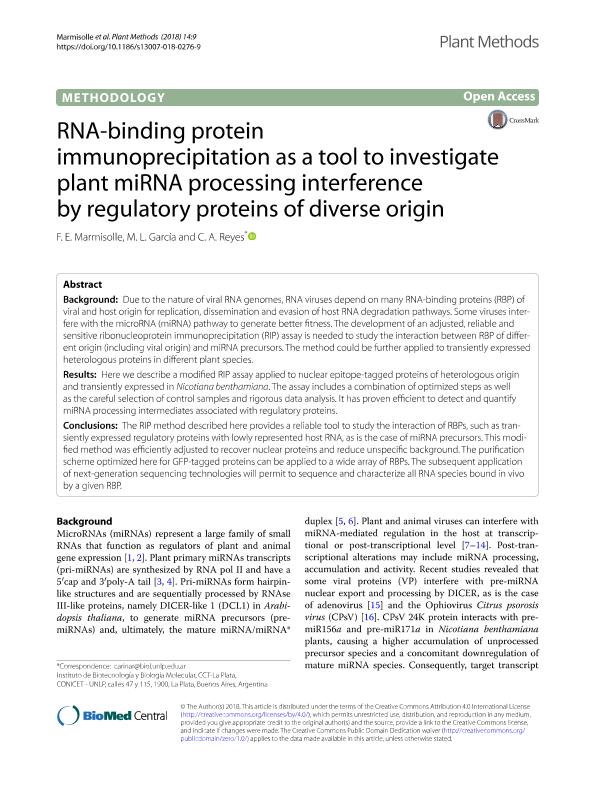Mostrar el registro sencillo del ítem
dc.contributor.author
Marmisollé, Facundo Ernesto

dc.contributor.author
Garcia, Maria Laura

dc.contributor.author
Reyes Martinez, Carina Andrea

dc.date.available
2020-02-07T21:11:48Z
dc.date.issued
2018-01
dc.identifier.citation
Marmisollé, Facundo Ernesto; Garcia, Maria Laura; Reyes Martinez, Carina Andrea; RNA-binding protein immunoprecipitation as a tool to investigate plant miRNA processing interference by regulatory proteins of diverse origin; BioMed Central; Plant Methods; 14; 1; 1-2018; 1-9
dc.identifier.issn
1746-4811
dc.identifier.uri
http://hdl.handle.net/11336/96970
dc.description.abstract
Background: Due to the nature of viral RNA genomes, RNA viruses depend on many RNA-binding proteins (RBP) of viral and host origin for replication, dissemination and evasion of host RNA degradation pathways. Some viruses interfere with the microRNA (miRNA) pathway to generate better fitness. The development of an adjusted, reliable and sensitive ribonucleoprotein immunoprecipitation (RIP) assay is needed to study the interaction between RBP of different origin (including viral origin) and miRNA precursors. The method could be further applied to transiently expressed heterologous proteins in different plant species. Results: Here we describe a modified RIP assay applied to nuclear epitope-tagged proteins of heterologous origin and transiently expressed in Nicotiana benthamiana. The assay includes a combination of optimized steps as well as the careful selection of control samples and rigorous data analysis. It has proven efficient to detect and quantify miRNA processing intermediates associated with regulatory proteins. Conclusions: The RIP method described here provides a reliable tool to study the interaction of RBPs, such as transiently expressed regulatory proteins with lowly represented host RNA, as is the case of miRNA precursors. This modified method was efficiently adjusted to recover nuclear proteins and reduce unspecific background. The purification scheme optimized here for GFP-tagged proteins can be applied to a wide array of RBPs. The subsequent application of next-generation sequencing technologies will permit to sequence and characterize all RNA species bound in vivo by a given RBP.
dc.format
application/pdf
dc.language.iso
eng
dc.publisher
BioMed Central

dc.rights
info:eu-repo/semantics/openAccess
dc.rights.uri
https://creativecommons.org/licenses/by-nc-sa/2.5/ar/
dc.subject
PROTEIN INTERACTION
dc.subject
IMMUNOPRECIPITATION
dc.subject
PROTEIN ANALYSIS
dc.subject
PRE-MIRNAS
dc.subject.classification
Otras Ciencias Biológicas

dc.subject.classification
Ciencias Biológicas

dc.subject.classification
CIENCIAS NATURALES Y EXACTAS

dc.title
RNA-binding protein immunoprecipitation as a tool to investigate plant miRNA processing interference by regulatory proteins of diverse origin
dc.type
info:eu-repo/semantics/article
dc.type
info:ar-repo/semantics/artículo
dc.type
info:eu-repo/semantics/publishedVersion
dc.date.updated
2019-10-04T13:41:16Z
dc.journal.volume
14
dc.journal.number
1
dc.journal.pagination
1-9
dc.journal.pais
Reino Unido

dc.journal.ciudad
Londres
dc.description.fil
Fil: Marmisollé, Facundo Ernesto. Consejo Nacional de Investigaciones Científicas y Técnicas. Centro Científico Tecnológico Conicet - La Plata. Instituto de Biotecnología y Biología Molecular. Universidad Nacional de La Plata. Facultad de Ciencias Exactas. Instituto de Biotecnología y Biología Molecular; Argentina
dc.description.fil
Fil: Garcia, Maria Laura. Consejo Nacional de Investigaciones Científicas y Técnicas. Centro Científico Tecnológico Conicet - La Plata. Instituto de Biotecnología y Biología Molecular. Universidad Nacional de La Plata. Facultad de Ciencias Exactas. Instituto de Biotecnología y Biología Molecular; Argentina
dc.description.fil
Fil: Reyes Martinez, Carina Andrea. Consejo Nacional de Investigaciones Científicas y Técnicas. Centro Científico Tecnológico Conicet - La Plata. Instituto de Biotecnología y Biología Molecular. Universidad Nacional de La Plata. Facultad de Ciencias Exactas. Instituto de Biotecnología y Biología Molecular; Argentina
dc.journal.title
Plant Methods

dc.relation.alternativeid
info:eu-repo/semantics/altIdentifier/doi/http://dx.doi.org/10.1186/s13007-018-0276-9
dc.relation.alternativeid
info:eu-repo/semantics/altIdentifier/url/https://plantmethods.biomedcentral.com/articles/10.1186/s13007-018-0276-9
Archivos asociados
